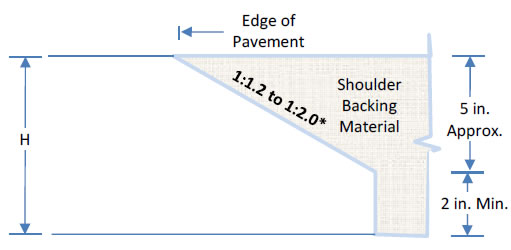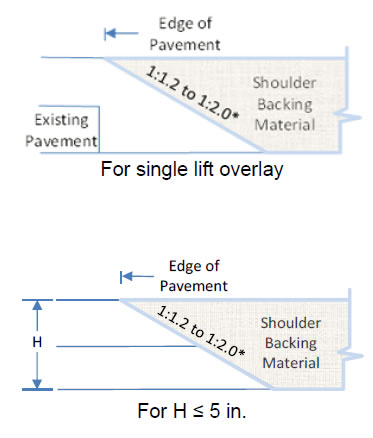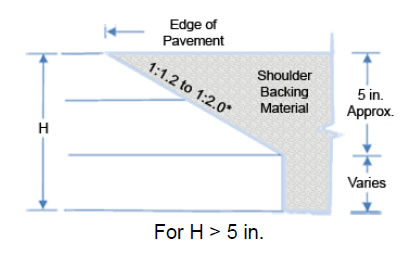DESCRIPTION
Incorporate a Safety EdgeSM to the dimensions shown and at locations designated on the contract documents. The finished shape of the Safety EdgeSM shall conform to the crosssection drawings shown in Exhibit A and Exhibit B.

Note 1*: Recommended Rise to Run ratio range 1:1.2 to 1:2.0. The range of slope is equal to 26° to 40°.
Exhibit A. Safety EdgeSM configuration for concrete pavements and concrete overlays.


Note 1*: Recommended Rise to Run ratio range 1:1.2 to 1:2.0. The range of slope is equal to 26° to 40°.
Exhibit B. Safety EdgeSM configurations for asphalt pavements and asphalt overlays.
EQUIPMENT
A. Asphalt Concrete Pavement (AC)
Utilize an approved Safety EdgeSM system to create a sloped edge profile onto the roadway shoulder. Utilize an approved Safety EdgeSM system that compacts the AC and provides a sloped wedge equal to1:1.2 to 1:2.0 measured from the pavement surface cross slope extended. The use of a single plate strike off is not allowed. The Safety EdgeSM shall be constructed monolithically with the AC pavement.
Utilize an approved Safety EdgeSM system that is adjustable to accommodate varying paving thicknesses.
All Safety EdgeSM systems to be used for the purpose of creating a Safety EdgeSM must meet the approval of the Engineer. The Engineer may require proof that the system has been used on previous projects with acceptable results or may require a test section constructed prior to the beginning of work to demonstrate the edge shape and compaction to the satisfaction of the Engineer.
B. Portland Cement Concrete
Modify paver screed to create a Safety EdgeSM that meets the final cross-section as detailed on the plans.
CONSTRUCTION METHODS
A. Shoulder Preparation
Prior to placing asphalt or concrete pavement, prepare the shoulder material where the Safety EdgeSM will be placed to provide a foundation that will support the placement of the Safety EdgeSM in accordance with the owner agency's standard practice.
B. AC Density Adjacent to Safety EdgeSM
For AC pavements and overlays, the percent compaction of the AC adjacent to the Safety EdgeSM shall be in accordance with the owner agency unconfined longitudinal edge specification.
C. Shoulder Backing Material
Furnish, place and compact shoulder backing material to the top of the Safety EdgeSM as shown in Exhibits A and B in accordance with the owner agency specifications. D. Handwork
AC
Obtain approval in advance from the Engineer for short sections of handwork such as transitions at driveways, intersections, interchanges, and bridges.
Portland Cement Concrete
In areas that do not require a Safety EdgeSM, e.g., intersections, bridges, etc., it is acceptable to saw cut and remove the Safety EdgeSM after paving operations are completed. In areas where it is not possible to place the Safety EdgeSM in conjunction with mainline paving but where the Safety EdgeSM is desired, the Engineer may allow handwork for short sections, for example at driveway transitions, intersections, interchanges, etc.
METHOD OF MEASUREMENT
Safety EdgeSM will not be measured for payment.
BASIS OF PAYMENT
No separate payment will be made for the construction of the Safety EdgeSM. All work associated in the Safety EdgeSM construction shall be integral to the pavement work and shall be included in the contract pricing for those pay items.
Page last modified on September 8, 2017
